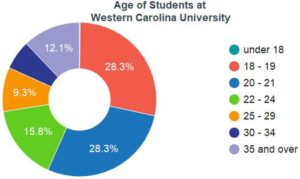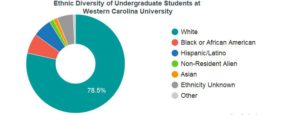Co-written with Allyson Wainright
The answer to our headline question depends on your definition of diversity. Diversity stems deeper than ethnicity and race, but as far as the eye can tell WCU is not diverse enough. There are a lot of changes taking place to instill more equity and an inclusive mindset for the students and community at WCU.
Diversity is a tricky thing to define as each person seems to have their own definition, but it all seems to boil down to the same thing: differences.

WCU’s student age demographics. Photo provided by https://www.collegefactual.com/colleges/western-carolina-university/student-life/diversity/.
Student Government Association (SGA) president, Matt Opinski defined diversity as being able to have different perspectives and different viewpoints, different cultures, all combined for the greater good of something. Chief Diversity Officer at the Office of Equal Opportunity and Diversity Programs, Dr. Ricardo Nazario y Colón, said his definition of diversity is differences as well.
“It is our understanding that each one of us has some uniqueness and that those uniquenesses can really add value to our experiences whether it’s on the job or in our community. When I approach work with diversity, I am looking for what’s the added value that every person brings to the table,” Nazario y Colón said.
Diversity is incredibly complex, as Nazario y Colón explains. It is all apart of a continuum made up of diversity, inclusion and equity. Diversity is about awareness of the things that make us unique and different. Inclusion takes on ways to contribute using these unique differences to benefit the community. Equity is more complex, questioning one’s treatment in comparison to others. Asking “is this fair?” Then, as a society we must discuss questions around power.
“It’s really a complex system of things that are interconnected and they build from one another. You can’t have equity without inclusion. You can’t have inclusion without awareness. We can’t have any of that if you don’t address issues of power,” Nazario y Colón said.
WCU is motivated to be very welcoming to diversity, but many students comment that although there is diversity at this school, it is not easily seen but rather, must be searched for.
See what they had to say in the video bellow.
When asked if WCU was a diverse place, Opinksi answered that there was not enough diversity.
“I just think that we don’t have enough policies in place that make us as inclusive as we possibly could be and that’s one thing that I’m trying to work on with SGA with all of our initiatives,” Opinski said.
SGA is developing a public awareness campaign about underrepresented groups and organizations, allowing for their personal stories to be told. The hope is to create more dialogue around the topic of diversity.
Another area that SGA is focusing on is the LGBTQIA+ community and how to implement more policies are LGBTQIA+ friendly. They hope to bring gender inclusive bathrooms to Western.
More long term goals include bringing a student union to campus. Opinksi thinks that a student union will allow an informal space for students from all different backgrounds to hang out and “simply be.”
Not to mention, it would allow for more student organizations offices.
Nazario y Colón is currently working on a community vision for inclusive excellence through a community statement. The key to this statement is “behavior.” People’s behavior matters and if anyone is purposefully demeaning or harassing someone, then WCU does not want to tolerate it. Ideals and actions like these help promote inclusiveness and equity not only at WCU, but in the entire Jackson County community.
WCU is making many efforts to be more inclusive to combat negative ideals about the school. WCU is no stranger to controversy when it comes to diversity. In 2018, racial slurs were shouted during the MLK march and more recently with the Gadfly controversy.

Statistics of ethnic diversity at WCU. Photo provided by https://www.collegefactual.com/colleges/western-carolina-university/student-life/diversity/.
It’s easy to hear stories like those and think that it is the norm at Western, but those negative instances don’t reflect Western as a whole. There are good and bad people here and it’s important to remember that, Nazario y Colón said.
“We are not our ghost stories,” Nazario y Colón said. “We can write our own narrative.”
Nazario y Colón recognizes that everybody has a different definition of diversity and that will affect their perception on whether or not they think WCU is diverse. Nazario y Colón poses a simple question, how do you measure diversity? Is it a feeling? Is it in the statistics?
“How do we know? When will we know? I hope it’s not an arbitrary line or statistic. I hope that it’s a feeling, to walk around campus like ‘hey I like it here’ or maybe it’s the moment when we are walking around and we don’t have to ask the question ‘are we diverse.’ Maybe that’s when we are diverse, when we no longer find ourselves finding the need to ask that question and we feel we are in such a good space and such a comfortable space that there’s no need for that question.” Nazario y Colón said.
Each of us has our own unique and individual understanding of the world. So, our interpretations of what is and what is not diverse may be very different from one another. Diversity is about more than just a person’s race or ethnicity. To make up a truly diverse population, people of all races, ethnicities, genders, sexualities, religious affiliations, people with disabilities, veterans and people of all economic backgrounds must be included.


